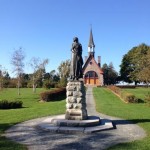
Tourist brochures on Nova Scotia tout the natural wonder of the 11 meters tides in Bay of Fundy’s Minas Basin as the highest in the world. They also call out also the internationally known the story of the diaspora of the Acadians; the French settlers who, forced out by the British, carried this distinctive culture across the globe.
What the region is less well known for is its significant cultural landscape. The Acadians had transformed the extensive salt marshes in the region into productive agricultural land from territory that was once the home of the native Mi’kmaq people. For 70 years, the settlers, using their knowledge of European techniques of dykes, ditches and sluices known as aboiteaux, created over 1000 hectares of good farmland. A collaborative community management system was created to construct and maintain hydraulic management of extensive dykelands. While working the land in this challenging natural environment, the settlers developed a culture and identity as Acadians. In the mid-18th century, as part of the British-French wars, the British authorities ordered the expulsion of the Acadian community from Grand Pré, transporting them to many places around the world. The British then enticed farmers from New England to settle these abandoned lands; and these farmers adapted the Acadian agricultural traditions. Their successors continue to farm this vast extent of dykelands today, still using a collaborative management system.

This agrarian landscape also became the most important place of remembrance for the diaspora of Acadians from around the world. Today this heritage has been recognized Grand Pré National Historic Site http://www.novascotia.com/see-do/attractions/grand-pr-national-historic-site/1335, which includes commemorative gardens, chapel and cemetery and a visitor center.
In 2012, the Landscape of Grand Pré was inscribed on the World Heritage List as a continuing cultural landscape. For over 300 years, these rich agricultural lands have been cultivated continuing a tradition of community-based environmental stewardship. The interaction of many generations of farmers, using their traditional cultural and ecological knowledge, with the rugged coastal environment of Grand Pré have created the values recognized by this World Heritage inscription.

The inscription of this living landscape reflects some fundamental shifts in the understanding of heritage that has begun to influence the types of places nominated as well as their management. In a landmark 1992 decision, the World Heritage Committee recognized cultural landscapes as eligible for the World Heritage List. This was a significant departure as the values of cultural landscapes derive from the interaction of people and their environment. In addition, there was growing recognition of the significant associations many communities and indigenous people had with their landscapes. Grand Pré is an example of this blending of cultural and nature that is still managed by the people who make a living from this resource.
Many thanks to Nora Mitchell who’s writing on World Heritage Cultural Landscapes and Grand Pre formed the backbone of this article.


